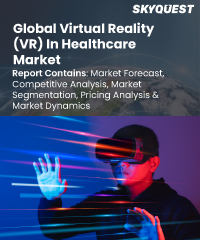
Product ID: SQSG35G2017

Report ID:
SQSG35G2017 |
Region:
Global |
Published Date: February, 2024
Pages:
157
|
Tables:
67 |
Figures:
75
Virtual Reality (VR) In Healthcare Market Driver
Virtual Reality (VR) In Healthcare Market Restraint
Low Adoption and Significant Costs for Equipment to Result in Slow Expansion
Our industry expert will work with you to provide you with customized data in a short amount of time.
REQUEST FREE CUSTOMIZATIONVirtual Reality (VR) In Healthcare Market size was valued at USD 2.89 billion in 2019 and is poised to grow from USD 4.03 billion in 2023 to USD 79.85 billion by 2031, growing at a CAGR of 39.36% in the forecast period (2024-2031).
Want to customize this report? This report can be personalized according to your needs. Our analysts and industry experts will work directly with you to understand your requirements and provide you with customized data in a short amount of time. We offer $1000 worth of FREE customization at the time of purchase.

Product ID: SQSG35G2017